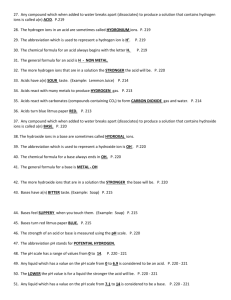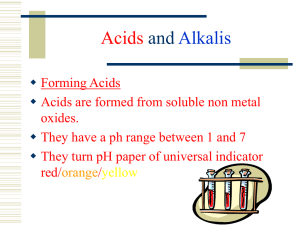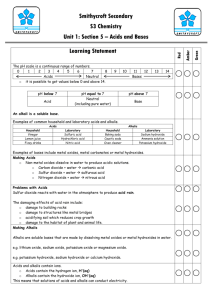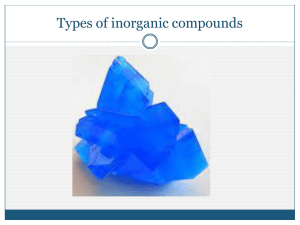The pH Scale - chemistryatstabs
advertisement
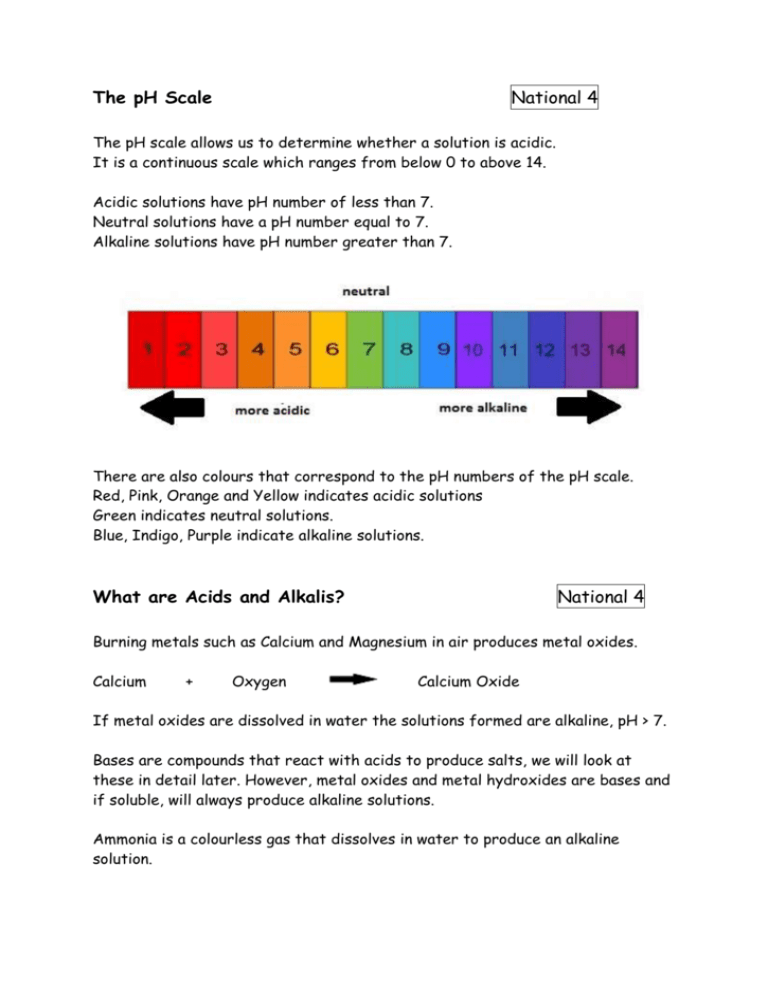
The pH Scale National 4 The pH scale allows us to determine whether a solution is acidic. It is a continuous scale which ranges from below 0 to above 14. Acidic solutions have pH number of less than 7. Neutral solutions have a pH number equal to 7. Alkaline solutions have pH number greater than 7. There are also colours that correspond to the pH numbers of the pH scale. Red, Pink, Orange and Yellow indicates acidic solutions Green indicates neutral solutions. Blue, Indigo, Purple indicate alkaline solutions. What are Acids and Alkalis? National 4 Burning metals such as Calcium and Magnesium in air produces metal oxides. Calcium + Oxygen Calcium Oxide If metal oxides are dissolved in water the solutions formed are alkaline, pH > 7. Bases are compounds that react with acids to produce salts, we will look at these in detail later. However, metal oxides and metal hydroxides are bases and if soluble, will always produce alkaline solutions. Ammonia is a colourless gas that dissolves in water to produce an alkaline solution. Burning non-metals such as Carbon or Sulphur in air produces non-metal oxides. Carbon + Oxygen Carbon Dioxide If these non-metal oxides dissolve in water, acidic solutions are formed. Solutions of non-metal oxides can have serious impacts on the environment. Uses of Acids and Alkalis National 4 Possibly without even noticing you will have come into contact with many acids and alkalis both at home and in the lab. The common lab acids are Hydrochloric acid, HCl, Sulphuric acid, H2SO4 and Nitric acid, HNO3. The most common lab alkalis are Sodium Hydroxide, NaOH, Potassium Hydroxide, KOH and Calcium Hydroxide, Ca(OH)2. At home you will have used Vinegar, Fruit Juice and Cola which are all acidic. Things like Bleach, Baking Soda and Washing Up Liquid are all alkaline. Conductivity of Acids and Alkalis National 4 Both acids and alkalis are good conductors of electricity. This means that both acids and alkalis are ionic compounds. Acids contain the hydrogen ion, H+. Alkalis contain the hydroxide ion, OH-. Water has a very low conductivity. This means there are very few ions present. Water is made up of mainly covalently bonded H2O molecules a few of which break up or dissociate into H+ and OH- ions. Concentration of Ions National 4 NEUTRAL Water and Neutral solutions contain equal concentrations of H+ and OH- ions. This means that the concentration of H+ and OH- ions is the same. ACIDIC Acidic solutions contain more H+ ions than OH- ions. ALKALINE EE Alkaline solutions contain more OH- ions than H+ ions. As you dilute an acid, the pH rises towards neutral, 7, and the acidity decreases. As you dilute an alkali, the pH falls towards neutral, 7, and the acidity increases. Acid Rain National 5 All fossil fuels contain a little sulphur as an impurity and when the fuels is burnt, the sulphur also burns. This produces the gas sulphur dioxide which dissolves in rainwater to make acid rain. Other gases such as nitrogen dioxide, which is produced by the sparking of air in car engines or during thunderstorms, can also produce acid rain. Acid rain is harmful in several ways: It damages buildings made of carbonate rocks such as limestone and marble It increases the rate of rusting of iron and steel It increases the acidity of soil, preventing growth or harming plants It is harmful to plant and animal life, particularly in rivers and lochs. Neutralisation National 4 Neutralisation is the cancelling out of an acid by another substance. The other substance is called a neutraliser. Neutralisation moves the pH of an acid up towards 7 or alkali down towards 7. As discussed earlier, a base is a substance that neutralises an acid to form a salt. Metal oxides, metal hydroxides and metal carbonates are all bases. Acid + Alkali National 5 Soluble metal hydroxides are alkalis. All of the reactions between acids and alkalis follow the general equation: ACID + ALKALI SALT + WATER For example: Hydrochloric Acid + Sodium Hydroxide HCl + NaOH Sodium Chloride + Water NaCl + H 2O We can write the equation showing the ions involved: H+ Cl- + Na+OH- Na+ Cl- + H 2O Not all of these ions are involved in the reaction. Looking at the above equation, there are 2 ions that do not change during the reaction. These are known as spectator ions because they do not take an active part in the reaction. We can write the equation again with the spectator ions, Na+ and Cl- removed. H+ + OH- H 2O So in the reaction between an acid and an alkali, the hydrogen and hydroxide ions react to form water Acid + Metal oxide National 5 Metal oxides which neutralise acids are often referred to as basic oxides. All reactions between acids and metal oxides follow the general equation: ACID + METAL OXIDE SALT + WATER For example: Hydrochloric Acid + Magnesium Oxide 2HCl + Magnesium Chloride + Water MgO MgCl2 + H 2O The equation showing the ions involved is: 2H+ Cl- + Mg2+ O2- Mg2+ (Cl-)2 + H 2O The equation with spectator ions omitted is: 2H+ + O2- H 2O So in the reaction between acids and metal oxides, the hydrogen and oxide ions react to form water. Acid + Metal Carbonates National 5 Many metal carbonates are insoluble and as such are useful neutralisers. This means that when all of the acid has been neutralised, any unreacted metal carbonate settle to the bottom of the test tube or beaker and can be removed by filtration. All reactions between acids and metal carbonates follow the general equation: ACID + METAL CARBONATE SALT + WATER + CARBON DIOXIDE For example: Hydrochloric Acid + Magnesium Carbonate Magnesium + Water + Carbon Chloride Dioxide 2HCl + MgCO3 MgCl2 The equation showing the ions involved is: 2H+Cl- + Mg2+ CO32- + H 2O Mg2+ (Cl-)2 + + CO2 H2O + CO2 The equation with spectator ions removed is: 2H+ CO32- + H 2O + CO2 So in the reaction between acids and metal carbonates, the hydrogen and carbonate ions react to from water and carbon dioxide. Acid + Metals National 5 The reactivity of a metal is important in determining whether a metal will neutralise an acid. Only metals which are above hydrogen in the electrochemical series, found in the data book, will react with acids. Metals such as Magnesium, Aluminium and Zinc are suitable neutralisers. All reactions between acids and suitable metals follow the general equation: ACID + METAL SALT + HYDROGEN For example: Hydrochloric Acid + Magnesium 2HCl + Magnesium Chloride + Hydrogen Mg MgCl2 + H2 The equation showing the ions involved is: 2H+Cl- + Mg2+ (Cl-)2 Mg + H2 The equation with spectator ions removed is: 2H+ + Mg Mg2+ + H2 So in the reaction between acids and metals, the hydrogen ions receive electrons from the metal to form hydrogen molecules. Everyday Neutralisations National 5 Indigestion caused by excess acid in your stomach can be treated using over the counter remedies such as Milk of Magnesia, Gaviscon or Rennies. These products contain bases like magnesium hydroxide, aluminium oxide and calcium carbonate which will neutralise the excess acid. Soil which is too acidic to grow crops can be neutralised by adding lime which has the chemical name calcium hydroxide. Lime is also used to reduce the acidity in rivers and lochs caused by acid rain. Acid-Base Titrations National 5 Titration is a technique which allows a solution of an alkali to be neutralised accurately by the addition of an acid using an indicator to determine when the solution becomes neutral. The apparatus used is set up as follows: A conical flask is filled with a known volume and concentration of alkali by using a pipette. A Burette is filled with a known concentration of acid. The tap is used to control the flow of acid into the conical flask containing the alkali. When the indicator changes, signifying that the solution is now neutral, this is known as the end point or equivalence point. The volume of acid added is noted from the burette. Titrations are carried out multiple times to ensure that the results are accurate. The first attempt is known as the Rough titration as this gives a rough estimate of the expected results. The titration is repeated until the results are concordant, meaning that results within 0.2ml of each other are obtained. Volumetric Titration Calculations National 5 What volume of 0.1 mol l-1 hydrochloric acid is required to neutralise 25cm3 of 0.2 mol l-1 sodium hydroxide? To do this calculation we can use the formula: Pacid x Vacid x Cacid = Palkali x Valkali x Calkali Where: P = Power (the number of H+ or OH- ions the acid/alkali has) V = Volume, in cm3 C = Concentration, in mol l-1 STEP 1 Write down the formula of acid and the alkali and work out their power Hydrochloric acid has the formula HCl and so has P = 1 Sodium Hydroxide has the formula NaOH and so has P = 1 STEP 2 Write down the volume and concentration information given for both acid and alkali in the question HCl has a concentration of 0.1 mol l-1 NaOH has a volume of 25cm3 and a concentration of 0.2 mol l-1 STEP 3 Put all of the values into the equation Pacid x Vacid x Cacid = Palkali x Valkali x Calkali 1 x Vacid x 0.1 = 1 x 25 x 0.2 0.1 Vacid = 5 Vacid = 5/0.1 Vacid = 50cm3 So, 50cm3 of 0.1 mol l-1 hydrochloric acid is neutralised by 25cm3 of 0.2 mol l-1 sodium hydroxide. What is a Salt? National 4/5 Salts are formed during neutralisation reactions. They are formed when the hydrogen ion of the acid is replaced by metal ions from the neutraliser. So in the reaction between hydrochloric acid and sodium chloride the H+ ion of the hydrochloric acid is replaced by the Na+ ion from the sodium hydroxide. This results in the salt, sodium chloride, NaCl, being formed. Naming Salts National 4 The name of a salt is derived from the metal ion of the neutraliser and the negative ion of the acid. Salts from Hydrochloric acid are called chlorides. Salts from Nitric acid are called nitrates. Salts from Sulphuric acids are called sulphates. For example: Name of the Acid Hydrochloric Hydrochloric Nitric Nitric Sulphuric Sulphuric Neutraliser Sodium hydroxide Copper (11) oxide Zinc (11) carbonate Potassium hydroxide Magnesium carbonate Aluminium Name of the Salt Sodium chloride Copper (11) chloride Zinc (11) nitrate Potassium nitrate Magnesium sulphate Aluminium sulphate Salts as Fertilisers National 5 There are a wide variety of uses for salts. One major use is as fertilisers. Fertilisers are compounds which restore essential elements back into the soil. Neutralisation reactions can be used to produce common fertilisers. Sulphuric Acid + Ammonia Nitric Acid + Potassium Hydroxide Nitric Acid + Ammonia Ammonium Sulphate + Water Potassium Nitrate + Water Ammonium Nitrate + Water In order to be effective fertilisers these salts must be soluble. Preparing a Soluble Salt National 5 Soluble salts can be produced by carrying out a neutralisation reaction and then removing any water formed by evaporation. For example: Add a spatula of calcium carbonate to 25cm3 of Hydrochloric acid and you will see effervescence as carbon dioxide is released. Continue to add small quantities of calcium carbonate until the effervescence stops and no more gas is released. Any unreacted neutraliser must be removed by filtration. The final stage is to remove the water from the salt solution by evaporation. Insoluble Salts National 5 Insoluble salts are prepared by carrying out precipitation reactions. Precipitation reactions involve mixing 2 soluble salt solutions which in turn produce 2 new salts, one of which is insoluble and falls out of solution appearing as a solid in the bottom of the beaker. For example: Lead Nitrate + Sodium Iodide (soluble) (soluble) Sodium Nitrate + Lead Iodide (soluble) (insoluble) When Lead Nitrate and Sodium Iodide are mixed, a yellow solid appears within the solution, this is the precipitate. This yellow solid is lead iodide which is insoluble. You can find out about the solubilty of salts by looking at the solubility table in the data book.
